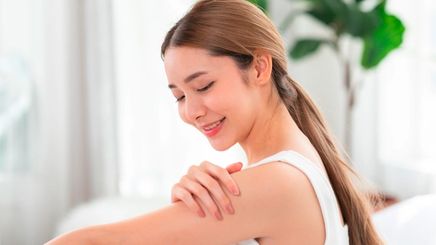
Talking about eczema conjures images of red, itchy skin surrounded by flakes. However, the condition itself is far more complex than just a rash. There are plenty of eczema types that can manifest in various ways. They may look similar at first glance but each one has its own triggers and requires different management.
Dealing with eczema can be frustrating, especially when you know next to nothing about it. To help take the stress away, we uncover the different types of eczema, plus what you can do to reduce the flare-ups.
Atopic Dermatitis
As one of the most common eczema types, atopic dermatitis or AD, occurs when the skin barrier is compromised and unable to retain enough moisture. A host of factors play a role in this skin disease, from a genetic mutation to an overactive immune system. However, researchers .
AD typically makes its debut in infancy and can persist into adulthood, although it’s possible for adults to have it later in life. Its trademark is scaly patches that most commonly appear on the skin folds, face, scalp, and hands. They also come with itchiness so intense it can lead to sleepless nights.
Treatment for AD involves a multi-pronged approach. First, cleanse and moisturize the skin with a hypoallergenic formula to restore its . Your dermatologist may also prescribe topical corticosteroids to reduce inflammation. For severe cases, weekly light therapy can help.
Contact Dermatitis
Contact dermatitis is categorized into two subtypes based on the trigger: irritant and allergic. The former is more common and happens when the skin is such as harsh detergents and soaps. Meanwhile, allergic contact dermatitis rears its head every time the skin touches allergens like, say, nickel in accessories or latex from wearing a bandage.
The telltale signs of contact dermatitis are not so different from other eczema types, except it can sometimes show up as hives and ooze pus. Your best bet is to remove the trigger ASAP and apply a cold compress on the affected area. If necessary, a doctor may step in with stronger oral medications.
When dealing with any type of eczema, it’s important to keep your skin hydrated at all times. Starts by removing potential irritants from your daily routine, including your body care. Dove Beauty Bar Sensitive is fragrance-free and hypoallergenic, suited for sensitive skin. It’s infused with ¼ moisturizing cream that nourishes the skin, leaving it soft and smooth.
You can also try using Dove Sensitive Skin Body Wash, the liquid alternative that boasts the same skin-friendly benefits and more. The sulfate-free formula is made with NutriumMoisture™ technology, which goes deep into the skin and helps replenish lost moisture. Plus, it’s refillable!
Seborrheic Dermatitis
If you’re wondering where you’ve heard the name before, here’s the hint: it has something to do with those pesky flakes on your scalp. Yes, dandruff is the mildest form of seborrheic dermatitis, which can extend beyond the hairline. But not all are eczema-related. Seborrheic dermatitis usually causes swelling and , unlike regular dandruff.
According to the , an anti-dandruff shampoo can be effective in controlling symptoms of seborrheic dermatitis. Look for ingredients like zinc pyrithione or ketoconazole to help curb the growth of Malassezia – a yeast-like fungus behind this bacterial skin rash.
Stasis Dermatitis
This eczema bears a striking resemblance to varicose veins. The culprit? Poor circulation in the lower legs resulting in fluid leakage. This causes swelling, redness, and eventually crusting. If left untreated, the skin may darken and form open sores or ulcers, which can be both painful and tricky to heal.
Prevention is key in dealing with stasis dermatitis. Simple measures such as elevating the legs whenever possible, staying physically active, and wearing compression socks can all improve blood circulation and minimize flare-ups. Nevertheless, avoid self-medicating and consult with healthcare professionals to get treated.
Dyshidrotic Eczema
Also known as pompholyx, dyshidrotic eczema is relatively rare among other eczema types. It primarily affects the hands and feet. And unlike most forms of , it turns up as a cluster of itchy little bubbles. When you scratch them, they burst with clear fluid and eventually create deep, painful cracks in the skin.
The cause of dyshidrotic eczema remains somewhat of a mystery, but experts believe it’s connected to stress and skin hypersensitivity. As far as treatment goes, the options are pretty much the same as atopic dermatitis. Even so, your first line of defense is keeping stress at bay.
Nummular Eczema
These coin-shaped rashes are raised, scaly, and unbearably itchy. They can appear anywhere on the body but are most frequently found on the arms and legs. While most eczema types are associated with genetics, and insect bites are the two common triggers of nummular eczema. Luckily, the rashes can heal on their own once you’ve addressed the root cause.
If you suspect that you have one of these eczema types, seek help from a dermatologist to have an accurate diagnosis and personalized treatment. With the right strategy and extra patience, you will overcome the struggle of dealing with this skin disease.